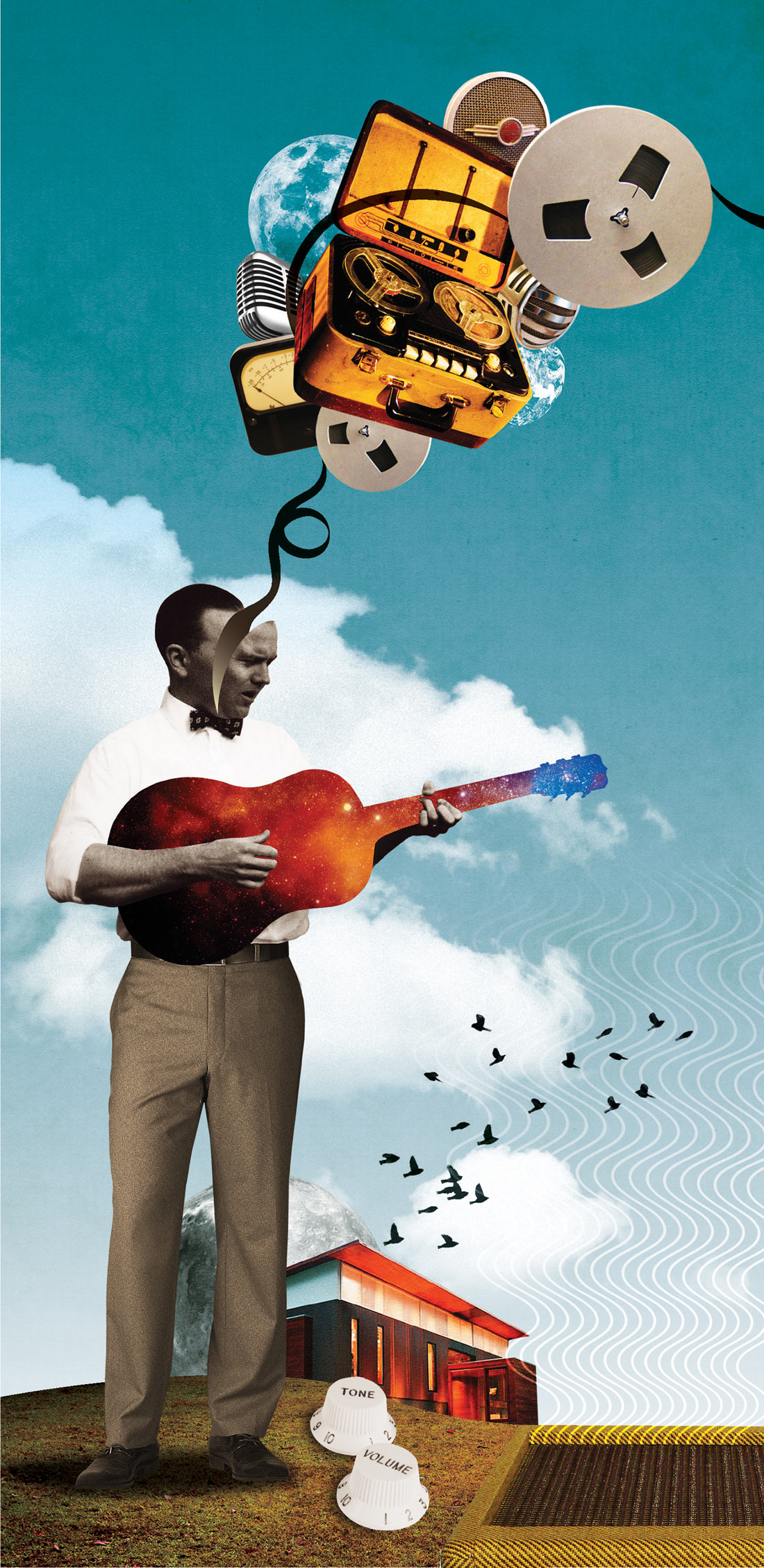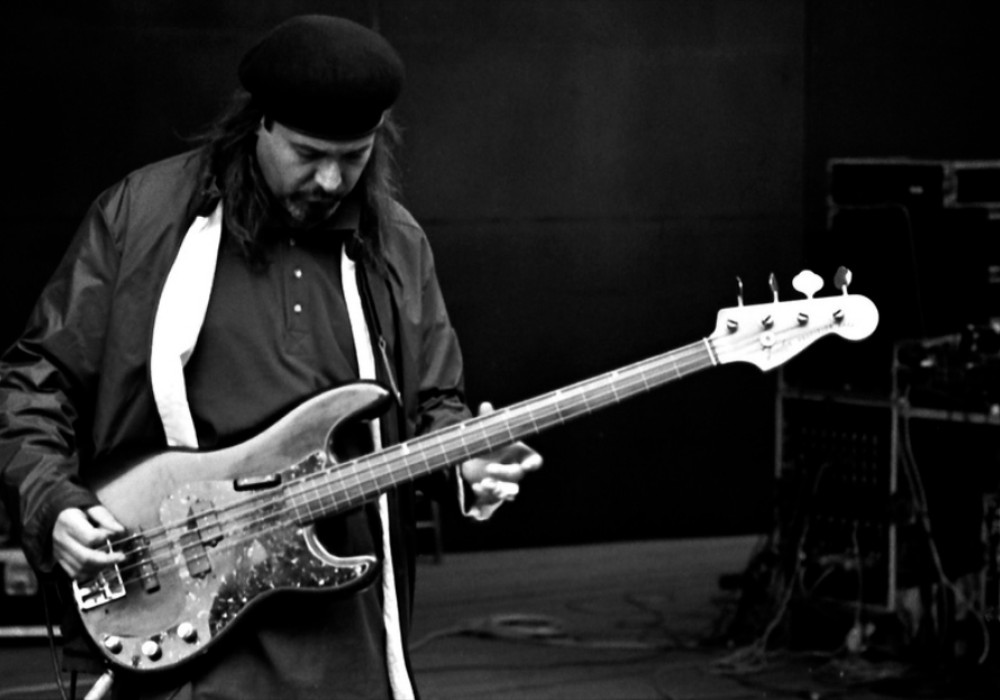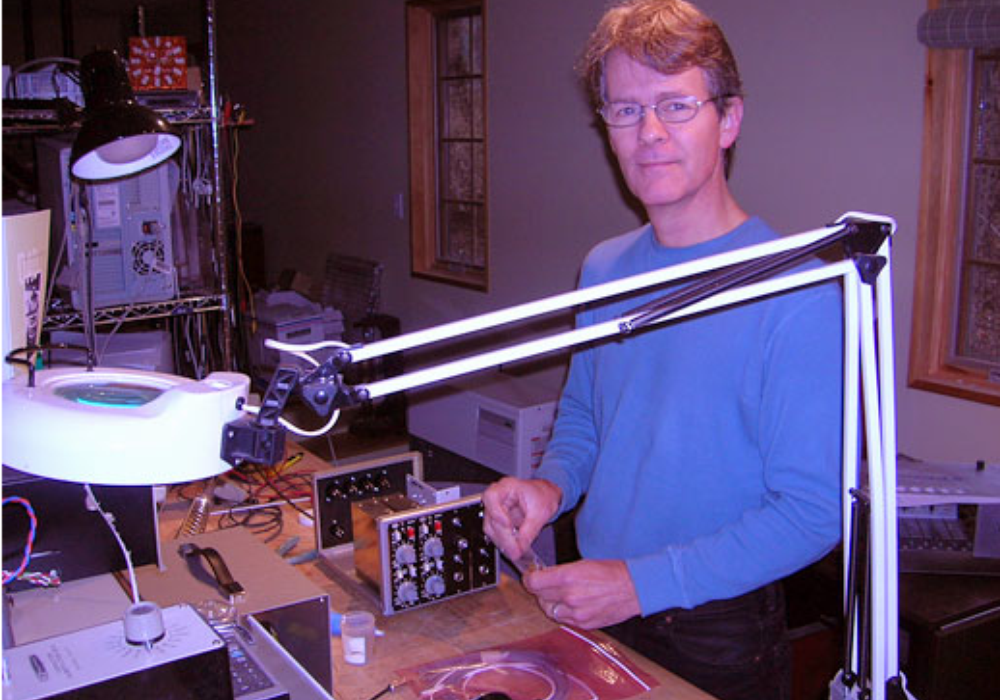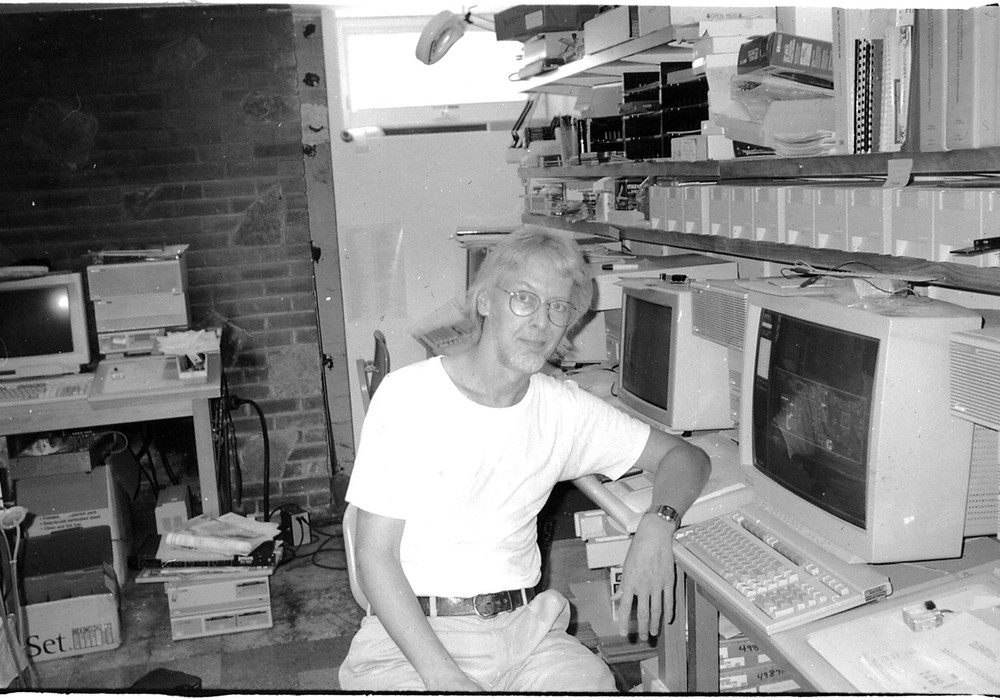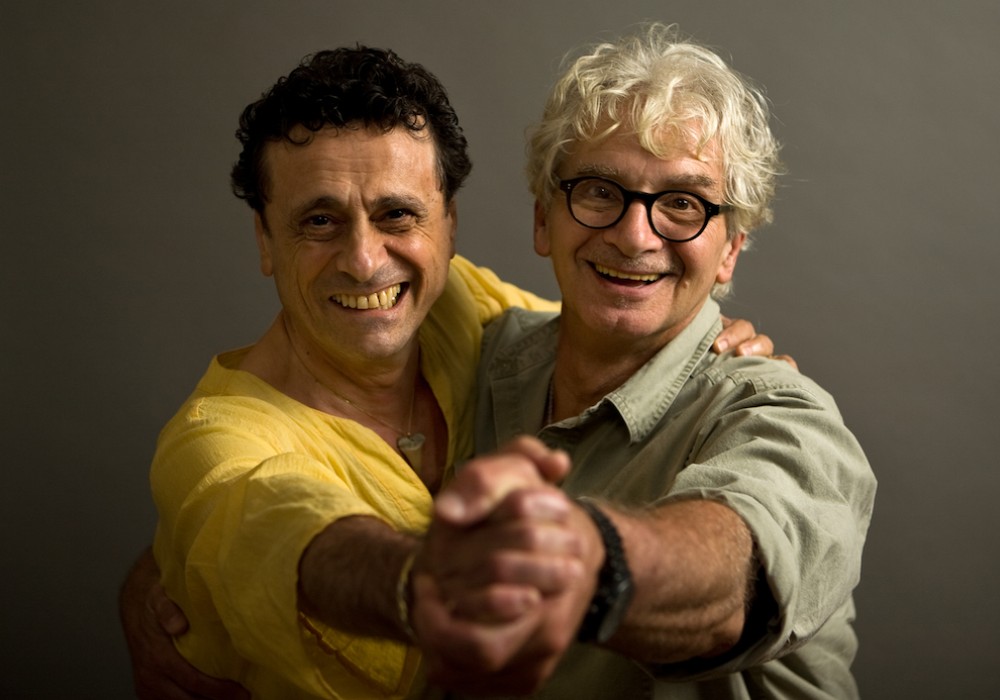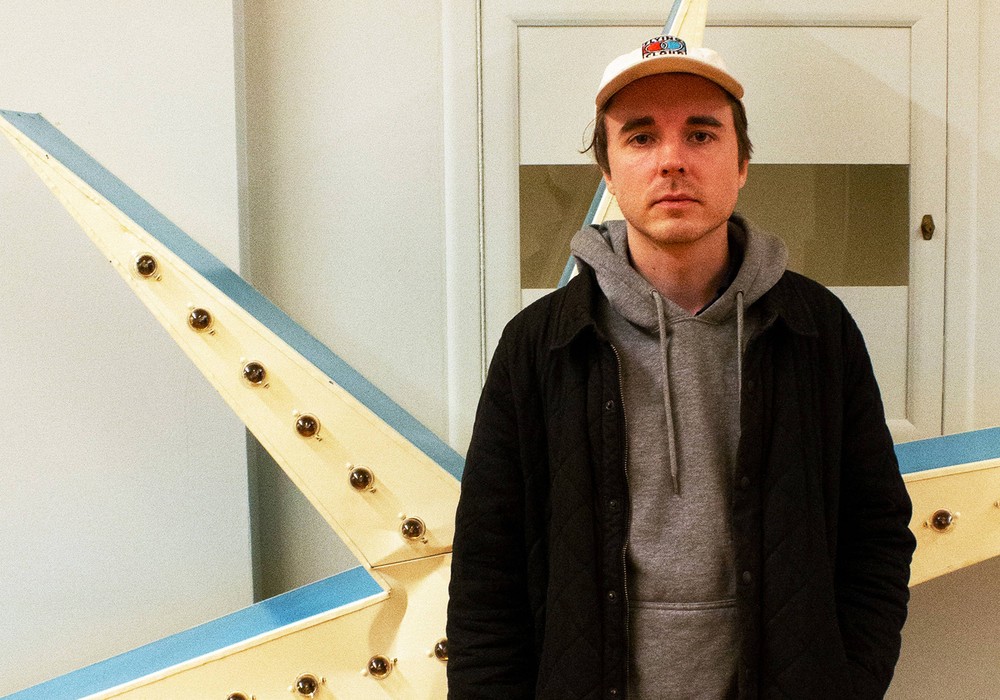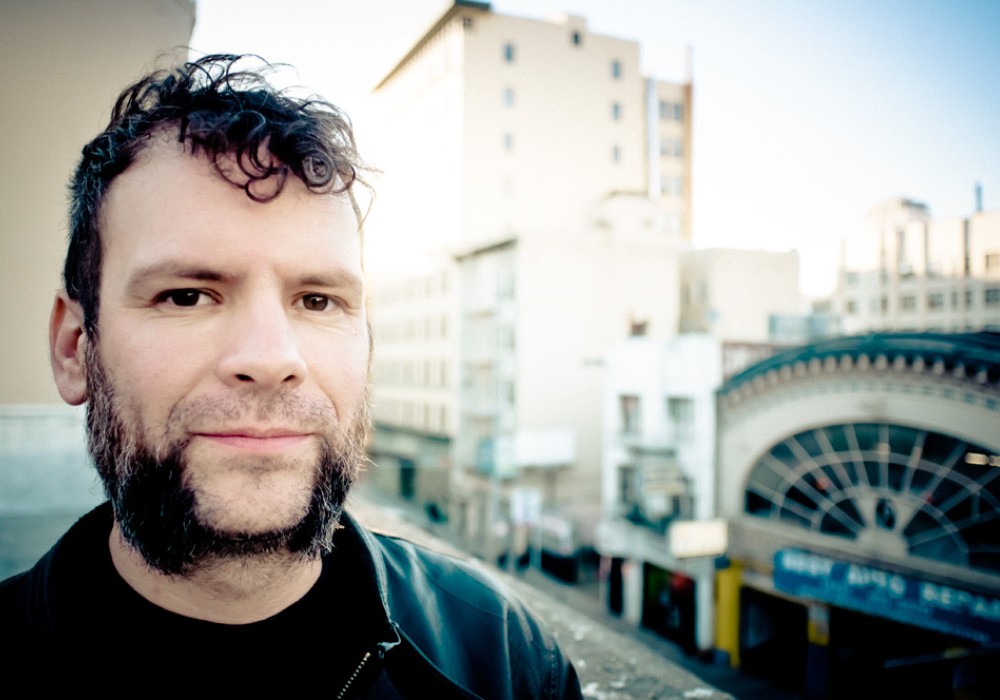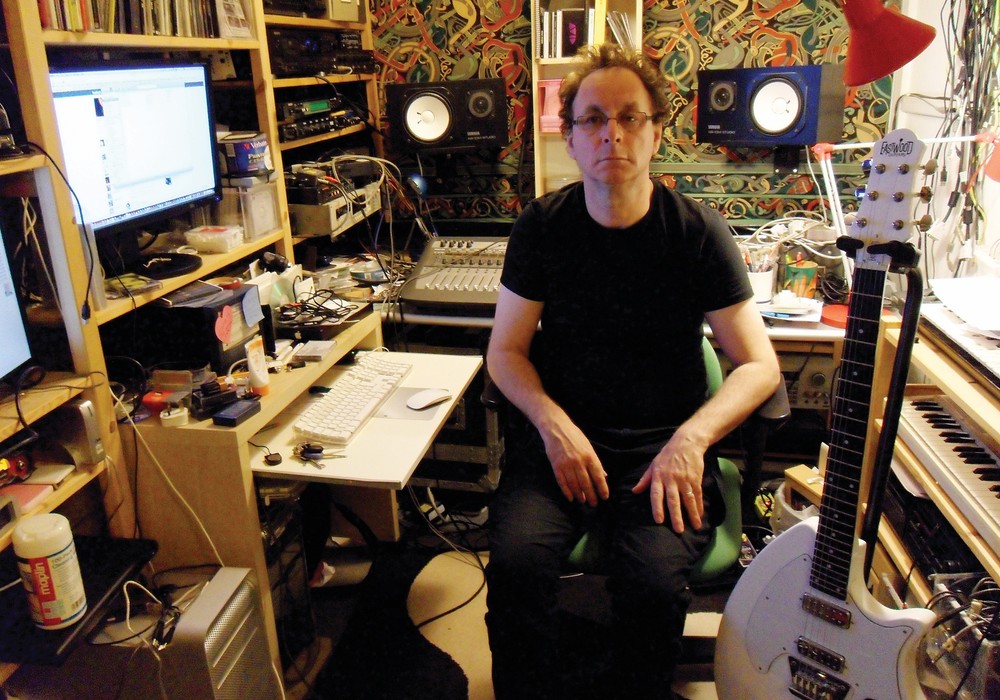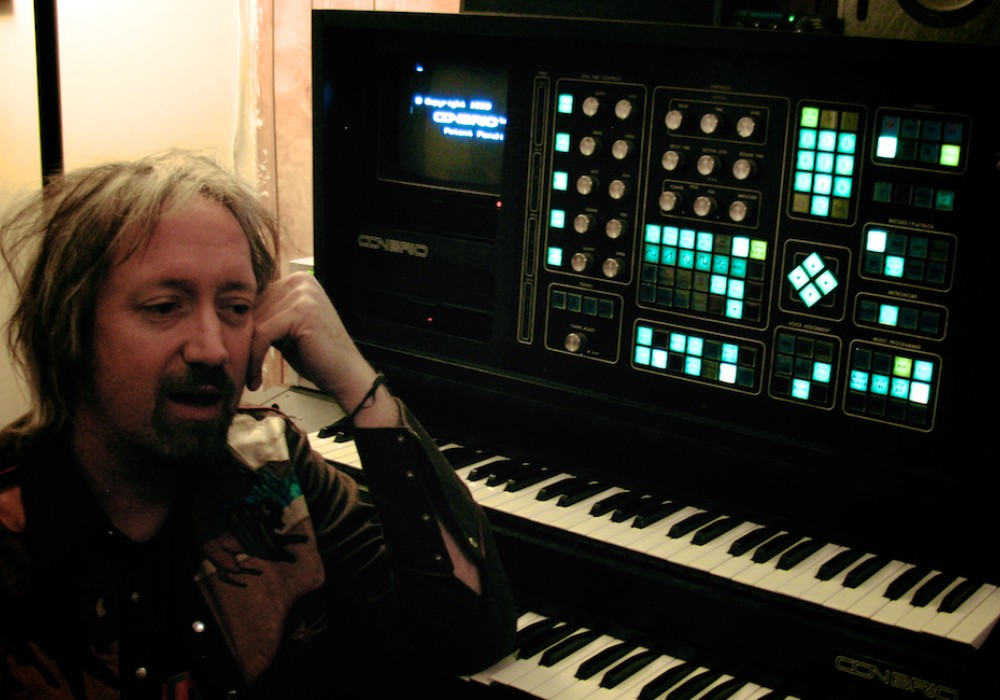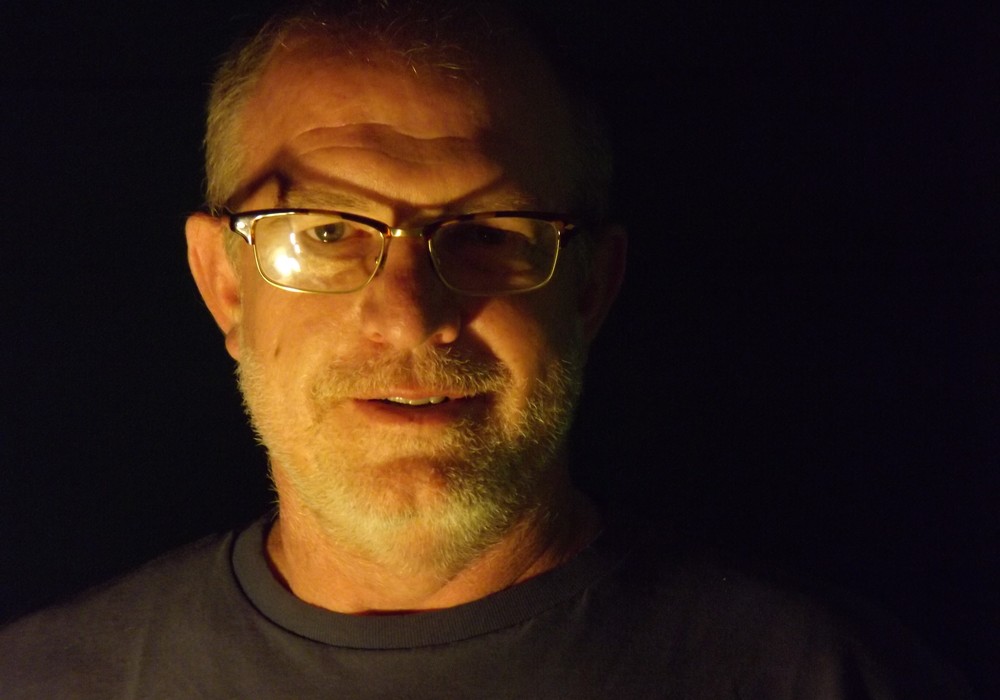Whether printing complex mixes, section-by-section, through old Neve consoles without automation to 1/2-inch tape, or hauling recording rigs and generators into the mountains of Morocco, Bill Laswell embodies a fearless resolve in creating a discography that no one can touch in terms of depth, breadth or sheer number of records produced. I started digging Laswell in the early 1980s, and was particularly intrigued with his fluency in the languages of then-nascent hip-hop, as well as reggae and the electric rock styles of West Africa. His incongruous collaborations with musicians from different parts of the planet, as well as regular use of some of my favorite musicians from the worlds of Parliament/Funkadelic and reggae were always wrapped in sounds, textures, and rhythms just a few steps ahead of the bleeding edge of NYC club styles. Everything that appeared with Laswell's name on it was a challenge of some sort, aggressively demolishing notions of genres while always expanding ideas of sonic possibilities. Some of the most interesting people and projects Bill has produced include Ornette Coleman, Santana, John Zorn, George Clinton, Pharoah Sanders, Iggy Pop, Herbie Hancock, Buckethead, William S. Burroughs, Tony Williams, James "Blood" Ulmer, PiL, Praxis, Material, as well as re-workings of Bob Marley and Miles Davis.
I've been a friend of Bill's since the late 1980s, via his long time engineer Robert Musso, who had initially hired me to run his MuWorks label. I went on to run Bill's Axiom Records for the first half of the 1990's. Bill also pushed me into founding the Tzadik label with John Zorn, and got me on the payrolls of Rykodisc, CMP and other labels as a consultant. Bill's blessings allowed me to travel worldwide, become friendly with many of my musical heroes, and, most importantly, spend a lot of time in the studio with him.
I wonder if you realized what you were coming up with when you created "Rockit" [from Herbie Hancock's Future Shock (1983)].
I had no idea.
How did you make that record? What was the strategy?
The strategy really came from the street. "We're going to take a couple of tracks to Herbie Hancock." I'd been going to the Roxy, and I'd been experiencing DJs, so my idea was to make a record where we featured a DJ playing. I programmed stuff, but I didn't even know how to program the drums — it was the Oberheim DMX. I didn't know how to make a sequence; I only knew how to make a beat. I went to the studio and I had to actually push the button for the next section, because I didn't know how to program the sequence. Once I got it on tape, I played a bass line on it. The bass line came from a Pharoah Sanders record called Tauhid; it's a vocal line that I took. The end of it is borrowed from Jimmy Castor Bunch — I took these two ideas and put them one in front of the other, and that was the bass line. Then I said, "I need a DJ. I need somebody to cut this like I've been hearing in the clubs, but who can play in time." Who's going to play in time, like a drummer? I called [Afrika] Bambaataa and he said, "I've got the guy. Cheese." I can't go to L.A. and say, "I've got this 'DJ Cheese' on the record." We called DJ Whiz Kid, but he'd just joined the Army or something. I said, "What about D.ST?" He said he could do it. I brought Grand Mixer D.ST [Derek Showard] from the Bronx to Brooklyn. He sat on the couch for ten minutes, I gave him $350, and he cut "Rockit" with his driver, some Puerto Rican guy, sitting there waiting. The driver made more money than he did. I had Daniel Ponce [congas] around those days, and I said, "Put an Afro-Cuban beat in there." He played it on the Batá [double-headed hand drum]. And that was "Rockit."
The Batá doesn't get recorded that much because it's a sacred instrument.
No, and not like that. The track was killing before we got to L.A.; it was already great. Herbie asked, "What am I going to play?" I said, "Think about Manu Dibango. Think about 'Chameleon.'" We pretty much hummed it to him.
The Sly & Robbie records, Rhythm Killers and Language Barrier, and then Material's The Third Power album, were pretty deep introductions of a lot of current Jamaican dancehall/DJ/rap stuff.
Yeah. Also Shinehead and Shabba Ranks. I think, for me, Rhythm Killers and those records, were an offshoot of the concept of [Afrika Bambaataa's] "Planet Rock," where you have black music with a mechanization of meter and metronome. It's much like the way the Germans do rhythms — like Kraftwerk and Neu! It's like this cold, rhythmic thing; and then you have this other syncopation on top of that. That was the concept. A lot of critics don't understand that; they think, "Oh, it's not funky." We weren't trying to be funky; we were trying to be new. And we were. I'm still recovering from that one, but I like the concept.
After "Rockit" suddenly you were a famous producer and it was time to produce Mick Jagger's She's the Boss.
Well, I wasn't really that known. I was known as the guy who was doing this new, hip stuff. I hadn't done a lot of work, but people like Mick Jagger were calling. I didn't know the Rolling Stones' music so much. I remember they called and said, "Do you want to come to Compass Point, Nassau, to meet Mick and talk about the recording process?" I was like, "Cool, but I need to bring somebody." I brought D.ST. We met at Chris Blackwell's house. Mick was very aloof, but kind of cool. We didn't say much. D.ST made a few comments that were quite humorous. We left it like that. I said, "Let's go back to the hotel, get something to drink, and call it a night." We got locked out of our apartment. Iron Maiden, who were living next door to us, broke into our house and got us into our room. The next morning we thought, "We are going back. It's a bust." Then Mick comes in and says, "When do we start the record? Who do you want to use?" I said, "Let's use Sly and Robbie. I also like Jeff Beck." It just went like that.
Your first Praxis album, 1984, was like Stockhausen.
I've forgotten the exact inspiration for it. But it was made up of vinyl and short-wave radio; and I also looped stuff. Those were primitive times; we didn't have sampling like we do now. We didn't have Pro Tools. I made the album as a goof to see what could happen. I forget what the inspiration for it was, to be honest. And I forget where the name really came from. But I kept the name and I kept the idea to experiment with sounds; later on it became a band.
How did that record get made?
I think somebody had called me about Buckethead; it was probably Brain, because I had worked with the band called Limbomaniacs with him as the drummer. He called me and said, "This guy's crazy. He plays guitar. He practices in his room and has all these crazy ideas. He wants to do something." I said, "Tell him to come to New York." And then we made that record. I got Bootsy Collins to come, which freaked Buckethead out because that was his hero. Brain came, and then I brought in Bernie [Worrell], which was the logical choice. Jungle Brothers were hanging around the studio. That's how it happened.
I remember Afrika trying to get the wah-wah pedal going on a turntable... How did you bring forth an album from that situation?
We worked with a little bit of structure. Somebody would have an idea or a riff; then we'd stabilize it, take care of the overdubs, and monitor it. It wasn't a free-for- all, for sure; it was a production.
And then you would edit it?
Not like you'd imagine. Mostly that was done in performance, like you'd do a pop record, almost.
What do you think made that album so special? It still freaks everybody out.
I think it's the energy of all the different people. It was random and it was new. Bootsy had never met Buckethead. Buckethead was really raw and his version was innocent. Bernie came in as a pro, and we had these other elements, like Jungle Brothers and other people hanging around. It was magical because of the moment. There was some directive — it was a production. I was conscious that it would be crazy.
Are there records where you've had a strategy that actually involved bringing people in to mix things up?
Not consciously, but ultimately it's a fact. That's a reality and a true thing. I'm not really conscious of it, but it happens for sure.
Do you walk into the studio with the attitude of, "I'm the producer"?
Sometimes. But other times I don't say anything.
What are some strategies that you've used in wrangling musicians in order to get them together to do something they haven't done before?
It's not really a stretch, normally. You lean on people who should be interested in what you're doing and should benefit from it. And that usually is a natural process — it's not a stretch.
How did you deal with the Miles Davis remixes (Panthalassa: The Music Of Miles Davis 1969-1974 — Reconstruction & Mix Translation)?
To this day I have everything from '69, up until '73 or '74, on multitrack. You deal with it as you would if you were there; you do the best you can with the music you have. It's intuition; there's no method really when you're dealing with that stuff. It's a mountain of recorded music and sounds. Did they pick the right takes and do the right thing with the records? Probably. There are endless outtakes and versions of stuff. I think it's a mistake to release them, especially when they put out 12 or 20 versions of the same song.
I think that's idiotic. There's a reason there are outtakes; somebody made a decision — let it be. It's intuitive. I grabbed the things that I related to, but it could have been done a million different ways. It happened that way because of that moment.
Were the drums recorded the way you would have liked?
Nothing's badly recorded. I have no regrets on Panthalassa; I think it's a great statement. I wouldn't change it for any reason. I wouldn't be here if it wasn't for that music. I knew Miles. I knew what I could have done with him, and we talked about a lot of things. It was a real experience; it's not just a fascination.
Did you propose Panthalassa?
I had to because one never knows who would get in there.
A few years ago some people from Columbia mentioned that they were getting ready to launch this extensive Miles Davis project and they asked, "Would you be interested in helping us with the box that would represent Miles' electric music?" I said, "I don't think I'm right for that. I don't have a good memory and I don't remember who played what." When it comes to remixing, that's different because it could be extend infinitely. But just to select and remaster — that's the job of an archivist and people that are librarians. I'm not good at any of that.
What is it that makes this late '60s and early '70s electric Miles music so deep for you?
It was the experience of that time. You're dealing with somebody who had a big history and background, and he's being bombarded by a lot of new sensibilities that he doesn't even pretend to try to emulate or understand, such as Jimi Hendrix, rock music, Sly Stone, and James Brown. He's feeling all that. He's not intellectualizing it. He's not figuring it out. He's not putting it in his version of it. It's energy, and he's doing it simultaneously with the times. That's all intuitive, based on strength of character and confidence. You're dealing with a massive presence, a huge ego, and extreme confidence — there had already been a long history, up to that point.
It must've been a lot different remixing the Bob Marley tapes [Dreams Of Freedom: Ambient Translations of Bob Marley in Dub].
I was visiting Chris Blackwell [former head of Island Records] in Jamaica and he had been listening to an ambient record we made called Lost in the Translation, which was basically mixing up the whole Axiom catalog. He asked me to try to do the same thing with Bob Marley. It took a long time to put it together, with the business and the tapes and everything, but it was Chris that initiated it and made it happen. I would have never come up with that, or even suggested it. Reggae has a history of reinterpretation with dub. My idea was to not feature his voice, because these were going to be dub records about the music. People have an affinity for this poetry. You don't want to really start fucking with that, so I dealt with the music like you would do with a dub record. The greatest dub records never had vocals.
How did you approach these remixes?
It's more like finding a center of a piece, without the lead vocal. Reggae is the beginning of people doing dub. It's about creating an atmosphere with parts that existed in a track, as well as not necessarily using the lead. That's traditional — the approach to breaking it down and taking things in and out. Added to that is atmospherics, and that's pretty much the concept. Every song was getting ready to be soaked and submerged in its own center. It wouldn't make sense to do a version that was too close to the original. By working with bass and drums, you see how they work together. Aston "Family Man" Barrett played more melody on the bass. His bass playing is more in line with the singing, like he's playing country music more than he's playing what people do in funk and R&B.
And Carlton "Carly" Barrett was sort of floating out there in between three and four.
It's a middle sound. But the drum and bass, if you look at it as far as tightness, you won't find that it has that kind of tightness...
With the kick and the bass?
No, no — it's very far removed because it needs the song to communicate the parts. And "Family Man" played very much on top of the beat. That style in reggae changed after that. No one played quite that much on top. The next generation — like Sly and Robbie — they were playing the rhythm section. Drum and bass were the tightest it could be.
Did you learn anything from these remix projects?
Yeah. I learn stuff all the time. I become it and it becomes part of how I make my next decisions. At no point do I say, "I think I figured that out," because I haven't figured out anything, from day one. You absorb that and it becomes part of what you do, and you bring that to somebody else. It's energy. There's no absolute, definite version of anything. What you're hearing — you call it "the music" — is a small tape, which was a product of a big tape, which was done on a certain date, which was intuitive according to the person that made that decision — not always the artist. But you get it as a fraction of the experience, and it's the version. That version is indefinite, endless. Just like with a symphony orchestra — a composer can write something one way, but everybody plays it different. Then it gets recorded different. It's not the way it was written in the composer's head. There are endless possibilities and endless versions of things.
For most of the '90s you were in the studio every day, if you were in town!
Yeah, I'm trying not to do that now. I'm even changing the studio. I painted stuff. I'm selling stuff.
The song "Mantra" on Material's Hallucination Engine was recorded in India, right?
That Mantra riff was based on a children's song, and we recorded it in a studio in Madras. The instrument is called a narsinga; it's a long horn. It was a circular rhythm, a cycle; I didn't have a beat for it, but I had a tempo. I told this kid in the studio that I needed a beat. I said, "Have you guys got any records? Can I sample some records?" He said, "No, we don't have any records." I said, "Go around the corner and buy some cassettes with beats on them." He came back and he had one record called [Sadeness (Part I)' by] Enigma. They had a beat: boom, batat-boom... And I said, "Okay, that will work." They couldn't even loop more than one bar. I looped that cassette and put it under this narsinga. I brought it back to the studio. We were recording Zakir [Hussain, tablas] for L. Shankar — and I said, "I want Zakir to play on this track." Shankar and his wife said, "Don't let him play crazy." And I said, "I want him to do whatever he wants." To Zakir I said, "Play whatever." He played it in one take. The car was waiting outside for me, honking the horn, and I asked, "How long's the track?" The reply was, "About seven minutes." And I said, "Run the tape." I played bass on it for seven minutes, done. One take. That's "Mantra."
Hallucination Engine was from a lot of different places.
Yeah, that took years. It went on so long finding people to come into town, adding, building, and taking things away. That took a very long time to mix.
It's hard to believe it was done without automation. You mixed by hand through those Neve consoles to 1/2- inch tape, section-by-section, and then spliced the bits of tape together.
It was an incredibly primitive way of doing it.
Do you miss working like that?
No, because it's still like that; it's still primitive. It's in Pro Tools, but it's still primitive in the sense that it is not calculated in the digital mind. It's raw and it's still intuitive. It has to be raw. I'm not cutting tape, but it's the same.
I have listened to that record a lot and I've imagined where edit points are, but I've never heard one.
You won't hear one. You'll hear somebody play something that sounds more like an edit than a real edit. With other formats it's seamless, and you can do it indefinitely; but sometimes you lose the story like that. Not to say you always have to cut tape — that's ridiculous.
How did you put together PiL's Album?
That was a trip. I'd been listening to a lot of South African music that put a straight 4/4 kick drum with the snare at the four, and also to Turkish music. It came to me, that this was the way to cut a track. I cut three tracks with myself, Nicky Skopelitis and Tony Williams. With Tony we cut them with one take; it was always one take. On "Rise," which was a big song, we dropped a beat somewhere. Instead of fixing it, I said, "Don't worry." We fixed it with a Fairlight [CMI]. On another track, I missed a note. I said, "I don't want to change it; I want to keep it at one take." It was a half-step off, so when everybody would overdub — Steve Vai and those guys — there's a half-step difference. We kept overdubbing over mistakes. The first PiL record [Public Image: First Issue] was a great statement. I tried to bring back a little bit of the second album, Metal Box, but also bring this African thing into it. With "Rise," John [Lydon] came with this Irish folk song concept of, "May the road rise with you." It came together quite quickly, starting with that Zulu music beat. And then Ginger Baker came in with all that African drumming.
It's quite a lineup of musicians! How did you choose who would play on it?
Randomly. Ginger was always a weird concept of John Lydon's, of fantasizing that Ginger Baker would be their drummer — it was a goof. I read that in a magazine and said, "That is a great idea." When it came time to record PiL, I told [my manager] Roger Trilling, "You need to find Ginger Baker." It took forever. We found him in Italy; I went over and brought him back. I also thought Tony Williams was one of the world's greatest drummers. So why not bring Tony in on everything? He should play on everybody's records.
You also produced Ginger Baker's Horses & Trees album.
That came from meeting Ginger, knowing who he was, and what he had done. We bum rushed him into making rhythms with African musicians. I'm sure he would have much rather done pop music, make hit records, and be a star; but we didn't have that kind of time and money. We made what we thought was appropriate for Ginger Baker. I thought it translated well, for the time. I came in and started playing, bringing in people and figuring that I would reconstruct it after the fact.
How did you put together Material's Seven Souls?
For Seven Souls, the tracks originated when I was doing a second record of PiL's for John Lydon. His band was coming to New York and we were going to make a record. Like I did with the previous PiL record, I would do at least three tracks to give to him. I recorded these tracks with Sly Dunbar and Nicky Skopelitis [guitar, electric sitar, 12-string], Jeff Bova [synths], Aïyb [Dieng, percussion], and L. Shankar [violin]. Then I had a serious falling out with John and said, "Fuck off" to the band and everybody. I kept the tracks. When I left [that situation with] John, I said, "Okay, this is not healthy." I went to Istanbul and I took the tracks. I had this cassette machine with a speaker in it; I would put it in the window and play the tracks. You could hear the prayer on top of the tracks. I thought, "You could make a record without singing. It could be a sound that floats over this music." As soon as I got back, I went to Fort Worth, Texas, where I met up with William Burroughs at the Caravan of Dreams [Performance Center]. They gave me his book, The Western Lands, and I read it. At the end of the book it sounds like he's leaving the planet. I had the tracks, I remembered the Turkish thing, and I thought, "Let's get William Burroughs to read over this." Burroughs was into it. I didn't go with him — I didn't want to go to the studio and say, "Once more, William. A little more tragic, maybe." I outlined the lines, he read it and we paid him. From PiL, to Turkey, back to Burroughs, to Dallas/Fort Worth, and finally back to New York.
Do you remember what your idea was when you were making those basic tracks? You were taking John Lydon somewhere.
I wasn't quite clear on where. It had a little bit of the Turkish thing in it, somehow. There was a lot of Middle East vibe in the air. I don't think Sly had a clue — he was just playing beats. I remember being in a van with Sly and the song came on the radio. Sly was like, "Drum and bass wicked!" He didn't even realize it was us playing! [laughing]
Your solo album, Hear No Evil, was a contemporary of Seven Souls.
They're from the same time, all that's part of the same experience. There was that moment of this connection with India and the Middle East. Zakir [Hussain], L. Shankar, and [Daniel] Ponce were around. We started to bring in this Middle Eastern thing, what they call now "world music." When Ronald Shannon Jackson heard it he said, "You know, it sounds like you are from the Midwest." And I said, "Why? I am from the Midwest." And he said, "Then you've made your record; that sounds like country music." To us, it was country music.
What made you want to make it a Bill Laswell record?
No idea. I guess because I was leading the whole thing, and I was the only one. It wasn't personal at the time, but I guess at the end of the day, it is.
What's the magic on those albums?
It's intuition and what catches up with you over time, where you come from. All this music comes out of life experience. It doesn't come from anywhere else; not from schools, not from teaching, not from suggestions. It comes from my life. My life comes from that background, from the Midwest, so it came out of that and put itself down. Certain times you don't have to lead, you don't have to necessarily direct, and you don't even have to know what you are doing. But, if you're available, you might get caught in an undertow of things.
It's certainly an interesting power to make a song, or a piece of music, when you are a bass player. You can say, "Here's the foundation."
On that record I played 6-string bass. I established slide stuff and different sounds. I tried to make it more of a top line idea, versus forming the foundation. I went to Long Island with Jean Karakos and we had a 4-track cassette recorder. I stayed in this room for three or four days and worked on ideas.
You demo'd it?
For myself, yeah. That's the first time I ever did that. I did it because I had these riffs, but they were a little longer than just a riff. They weren't a bass line. They were something else. I needed to memorize them. A bass line you can remember, but something that goes on for 16 bars that you have to memorize.
What have you been doing in Japan lately?
I've been developing things in Japan for years. The latest is called "Tokyo Rotation," and it's a series of events that we do every year with different artists. About 20 or 30 musicians each year come together and make this thing. This year I played with the Gagaku Orchestra, DJ Krush, and no drummer — we played with the orchestra. I did separate gigs with [trumpet player Toshinori] Kondo and [drummer Hideo] Yamaki, as well as all the people that we normally play with. It's been building up over a long period of time.
The Method of Defiance group is an amazing blend of elements.
We've created a label called M.O.D. Technologies, and we continue working with that label. That's also the M.O.D. group with DJ Krush, Dr. Israel, Bernie Worrell. That also includes Garrison Hawk ("Hawkman" from Jamaica), with Toshinori Kondo and Hideo Yamaki from Japan. We built this label based around this band, and from that I started to produce other records for the label including Lee "Scratch" Perry, my wife Gigi, Hawk, and Praxis.
I heard the live M.O.D. stuff and it's completely insane. How do you make a record with a group like that?
You do it step by step. It's a production; it's a process. Sometimes you record a band, other times you get a drum track and overdub on top of it. It's all the same, if you know what you're doing.
Last Exit was a pure improvisational noise band. How do you make a Last Exit record?
You go and hope for the best. We don't have much of a concept, but we have experience playing together. Last Exit is, of course, much better live and should have only been live. Records are Xeroxes of experiences and thought. They're what we do. For the most part, life is all wasted on crap — everything we hear and experience, that we're bludgeoned with daily. But there is a way to get to it that is intuitive and natural. I've experienced it recently with the Gagaku Orchestra. I've done it with DJs. These are all systems. You think you know somebody that's great? They're manipulating a system that they learned, a sequence. Songwriting is construction of existing parts that have already been anticipated, already experienced. You get beyond that and you get to the pure tone of the pure sound; the pure sound statement of your life experience. Then you'll get some music. All this stuff is just toil until it happens, and it can happen. It comes in flashes and moments; little glimpses of what's there. I would throw it all away — every ounce and every millisecond — for one glimpse of what's next. What's next is what you do next, if you know what you're doing. But I'm convinced no one knows what they're doing. I keep moving to that point, to that light. It hasn't happened yet. I look at the redundancy, the ignorance, the mindless rhetoric, repetition and nonsense that goes on. They call it music, entertainment, pop, and jazz. It's embarrassing, really. It hasn't happened yet. But there's always a shot; there's always a chance. I just hope that I can continue exactly what I'm doing and not look back.
